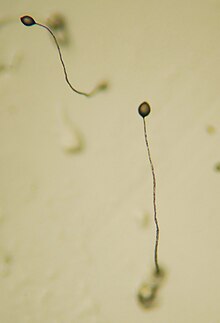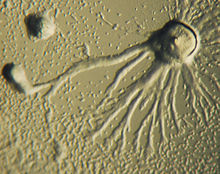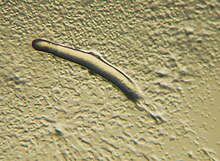Dictyostelium
| Dictyostelium | |
|---|---|

| |
| Dictyostelium fruiting bodies | |
| Scientific classification | |
| Domain: | Eukaryota |
| Phylum: | Amoebozoa |
| Class: | Dictyostelia |
| Order: | Dictyosteliida |
| Family: | Dictyosteliidae
|
| Genus: | Dictyostelium Bref. |
| Type species | |
| Dictyostelium mucoroides Brefeld 1869
| |
| Synonyms | |
| |




Dictyostelium is a
The genus Dictyostelium is in the
Discovery
The cellular slime mold was formerly considered to be fungi following their discovery in 1869 by Brefeld. Although they resemble fungi in some respects, they have been included in the kingdom Protista.[4] Individual cells resemble small amoebae in their movement and feeding, and so are referred to as myxamoebae. D. discoideum is the most studied of the genus.
Traits
Most of its life, this haploid social amoeba undergoes a vegetative cycle, preying upon bacteria in the soil, and periodically dividing mitotically. When food is scarce, either the sexual cycle or the social cycle begins. Under the social cycle, amoebae aggregate in response to
When starved for their bacterial food supply and exposed to dark, moist conditions,
Social characteristics
Professor John Tyler Bonner (1920-2019) spent a lifetime researching the slime molds and created a number of fascinating films in the 1940s to show the life cycle; he mostly studied D. discoideum. In the videos, intelligence appears to be observed as the single cells, after separation, regroup into a cellular mass. The time-lapse film captivated audiences; indeed, Bonner when giving conferences stated that the film "always stole the show".[10] The video is available on YouTube.[11]
When the organisms congregate, the mass is made of genetically distinct cells. Through natural selection, it is determined which of the organisms' genetic information will be present in future generations. The conflict is evidenced by unequal representations of two genetically different clones in spores of a chimera, the reduction of functionality seen in migrating chimeras, and a differentiation inducing factor (DIF) system, akin to poison, that appears to be made of cells forcing others to cease output of genetic information.[12]
Species
Taxonomy of Dictyostelium is complicated. It has also been confused by the different forms in the life cycle stages and by the similar Polysphondylium spp. Below are some reported examples.[13]
- ?Dictyostelium annularibasimum Li, Liu & Zhao 2016
- ?Dictyostelium arabicum Hagiwara 1991
- ?Dictyostelium barbarae Stephenson et al. 2019
- ?Dictyostelium culliculosum Li & He 2008
- ?Dictyostelium dichotomum Vadell & Cavender 2007
- ?Dictyostelium germanicum Cavender et al. 1995
- ?Dictyostelium globisporum Li & Liu 2011
- ?Dictyostelium insulinativitatis Stephenson et al. 2019
- ?Dictyostelium irregularis Olive et al. 1967
- ?Dictyostelium magnum Hagiw. 1983
- ?Dictyostelium microsorocarpum Li & He 2010
- ?Dictyostelium roseum van Tieghem 1880
- ?Dictyostelium vermiformum Vadell & Cavender 2007
- Dictyostelium ammophilum Romeralo et al. 2010 ex Baldauf, Sheikh & Thulin 2017
- Dictyostelium aureocephalum Hagiwara 1991
- Dictyostelium aureum Olive 1901
- Dictyostelium austroandinum Vadell et al. 2011
- Dictyostelium barbibulus Perrigo & Romeralo 2013
- Dictyostelium brefeldianum Hagiw. 1984
- Dictyostelium brevicaule Olive 1901
- Dictyostelium brunneum Kawabe 1982
- Dictyostelium capitatum Hagiwara 1983
- Dictyostelium chordatum Vadell et al. 2011
- Dictyostelium citrinum Vadell et al. 1995
- Dictyostelium clavatum Hagiwara 1992
- Dictyostelium crassicaule Hagiwara 1984
- Dictyostelium dimigraformum Cavender 1970
- Dictyostelium discoideum Raper 1935[14]
- Dictyostelium firmibasis Hagiwara 1971
- Dictyostelium gargantuum Vadell et al. 2011
- Dictyostelium giganteum Singh 1947
- Dictyostelium implicatum Hagiwara 1984
- Dictyostelium intermedium Cavender 1976
- Dictyostelium leptosomopsis Vadell et al. 2011
- Dictyostelium leptosomum Cavender et al. 2002
- Dictyostelium longosporum Hagiwara 1983
- Dictyostelium macrocephalum Hagiwara 1985
- Dictyostelium medium Hagiwara 1992
- Dictyostelium mucoroides Brefeld 1869
- Dictyostelium pseudobrefeldianum Hagiwara 1996
- Dictyostelium purpureum Olive 1901
- Dictyostelium quercibrachium Cavender et al. 2002
- Dictyostelium robustum Hagiwara 1996
- Dictyostelium rosarium Raper & Cavender 1968
- Dictyostelium septentrionale Cavender 1978
- Dictyostelium sphaerocephalum (Oudem. 1885) Saccardo, Marchal & Marchal 1885
- Dictyostelium valdivianum Vadell et al. 2011
References
- ^ Landolt. C. (2006) Dictyostelid Cellular Slime Molds from Caves. Journal of Cave and Karst studies v. 68 no. 1 pp. 22-26.
- S2CID 232092012.
- ^ "About Dictyostelium". dictybase.org.
- ISBN 0-521-58364-0.
- ^ S2CID 205599638.
- ^ Macinnes MA, Francis D. Meiosis in Dictyostelium mucoroides. Nature. 1974 Sep 27;251(5473):321-4. doi: 10.1038/251321a0. PMID 4473717
- ^ "Dictyostelium". www.ruf.rice.edu.
- ^ "dictyBase Home". dictybase.org.
- PMID 30701199.
- ^ "The Embryo Project Encyclopedia". Archived from the original on 2012-03-14. Retrieved 2011-07-16.
- ^ Archived at Ghostarchive and the Wayback Machine: Princeton University (22 January 2010). "John Bonner's slime mold movies" – via YouTube.
- S2CID 775816.
- PMID 29367151.
- ^ Raper, K.B. (1935). "Dictyostelium discoideum, a new species of slime mold from decaying forest leaves". Journal of Agricultural Research. 50: 135–147. Archived from the original on 2017-12-08. Retrieved 2017-12-08.
